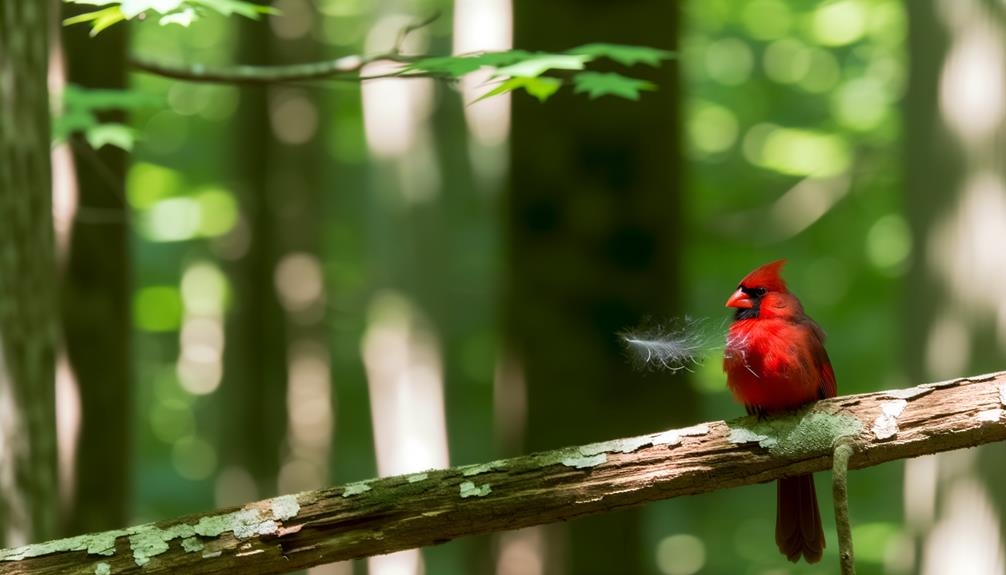Do Male Cardinals Lose Their Feathers Easily and How to Recognize It?
Male cardinals don't shed their feathers easily; they go through an annual molting process after the breeding season. This process is energy-intensive and essential for maintaining best flight and insulation.
Feather loss occurs symmetrically to avoid flight impairment. Seasonal changes, nutrient deficiencies, and parasites like mites can affect feather health.
Environmental stressors, such as pollution and food scarcity, also contribute. Keeping an eye on their diet helps prevent abnormal feather shedding.
If their feather conditions intrigue you, gaining insight into the intricate details of their molting cycles and preventive measures would be enlightening.

Key Takeaways
- Male cardinals undergo annual molting, leading to temporary feather loss post-breeding season.
- Nutritional deficiencies can cause increased feather loss and poor feather quality in male cardinals.
- Parasites like mites and lice can significantly increase feather loss in male cardinals.
- Environmental stressors, such as pollution and food scarcity, impact feather health and loss.
- Viral diseases can cause abnormal feather loss, different from the normal molting process.
Natural Molting Process
During the natural shedding process, male cardinals discard their old feathers to make way for new growth, ensuring the best flight and insulation capabilities.
You'll observe this typically once a year, often post-breeding season.
Molting is an energy-intensive period where cardinals replace worn-out feathers with fresh ones. This process is essential for maintaining ideal aerodynamic function and thermal regulation.
Scientific studies reveal that feather loss occurs in a symmetrical pattern, minimizing flight impairment.
It's interesting to note that the emerging feathers, or pin feathers, contain blood vessels that supply necessary nutrients for growth.
Seasonal Changes
Observing seasonal changes in male cardinals reveals how temperature fluctuations and daylight variations impact their behavior and physiology.
You'll notice that as daylight increases in spring, male cardinals undergo hormonal changes that trigger the molting of old feathers, making way for vibrant new plumage. This process is essential for attracting mates and establishing territories.
During colder months, the reduced daylight and lower temperatures slow down their metabolic rates, often resulting in less frequent feather loss. Studies show that this seasonal adaptation helps conserve energy and maintain ideal body insulation.
Dietary Factors
As you consider how seasonal changes affect male cardinals, it's also important to examine how their diet plays a role in feather health and molting efficiency. Nutrient deficiencies, particularly in protein, vitamins A, and E, can compromise feather integrity. Cardinals rely heavily on seeds, fruits, and insects, which should provide these essential nutrients.
Research indicates that a diet rich in carotenoids, found in bright-colored fruits and vegetables, enhances feather pigmentation and overall health. Observations show that cardinals with access to diverse food sources exhibit less feather loss.
Ensuring a balanced diet is vital for maintaining feather strength and promoting efficient molting cycles, thereby reducing the likelihood of abnormal or premature feather shedding.
Parasites and Pests
You might notice that male cardinals losing feathers often suffer from common feather parasites like mites and lice. These parasites can cause significant damage to the feathers and skin, leading to bald patches and discomfort.
Effective prevention and treatment strategies include maintaining clean bird feeders and using specialized anti-parasitic treatments.
Common Feather Parasites
Feather parasites, such as mites and lice, are common culprits behind male cardinals losing their feathers. Mites, including feather mites and quill mites, burrow into the feathers and skin, feeding on blood and keratin. Lice, on the other hand, chew on the feathers' structure, leading to significant damage and loss.
Studies show that infested birds often groom excessively, attempting to rid themselves of these parasites. You might notice bare patches or irregular feather growth as a result. Observational data suggest that during warmer months, parasitic infestations spike, correlating with increased feather loss.
Effects on Cardinals
Parasitic infestations and pest attacks degrade a cardinal's feather condition, affecting its overall health and ability to thrive in its environment.
When mites or lice infest a cardinal, they feed on blood and feathers, causing irritation and feather loss. This not only compromises the bird's insulation but also impairs its flight efficiency.
Studies show that heavily infested cardinals experience reduced reproductive success due to the energy expended in dealing with these parasites. Additionally, feather loss can make cardinals more susceptible to predation, as their vibrant plumage is essential for camouflage.
In addition, parasites can transmit diseases, further weakening the bird's immune system. Observing these impacts helps you understand the critical role of feather integrity in a cardinal's life.
Prevention and Treatment
Understanding the harmful impact of parasitic infestations on cardinals highlights the importance of implementing effective prevention and treatment strategies to safeguard their health. You can reduce infestations by maintaining clean feeders and birdhouses, which disrupts the life cycle of parasites. Regular monitoring allows you to detect early signs of mite or lice presence. Using bird-safe sprays and treatments can eradicate existing pests without harming the cardinals.
| Prevention Strategy | Description | Effectiveness |
|---|---|---|
| Clean Feeders | Regular cleaning of feeders | High |
| Nest Box Maintenance | Periodic cleaning and inspection | Moderate |
| Bird-Safe Treatments | Sprays and powders for pests | High |
| Environmental Control | Managing surrounding vegetation | Moderate |
| Early Detection | Frequent monitoring | High |
Implement these strategies to safeguard a healthy cardinal population.
Environmental Stressors
Environmental stressors, such as habitat destruction and climate change, greatly impact male cardinals' feather health and overall well-being. When you observe these birds, you'll notice that alterations in their environment can lead to significant feather loss.
Research shows that environmental stressors can trigger:
- Pollution: Contaminants in the air and water can damage feather structure.
- Food scarcity: Lack of essential nutrients affects feather regeneration.
- Temperature fluctuations: Extreme weather conditions stress the birds, causing feather deterioration.
- Human activity: Urban development reduces safe nesting areas, increasing stress.
Detailed studies link these factors to compromised feather integrity, highlighting the importance of stable habitats for their survival.
Health Issues
You'll find that feather loss in male cardinals can often be attributed to several health issues, including parasitic infestations and bacterial infections. Studies indicate that common diseases like avian pox and mites notably impact feather integrity.
Additionally, nutritional deficiencies, particularly in proteins and vitamins, can exacerbate the condition, leading to poor feather quality and increased susceptibility to damage.
Feather Loss Causes
A primary cause of feather loss in male cardinals is parasitic infection, with mites being the most frequently implicated offenders. These tiny arthropods can wreak havoc on a cardinal's plumage, leading to significant feather damage and loss. You might observe bare patches on the bird, particularly around the head and neck, if mites are present.
Mite infestations can result in:
- Intense itching and irritation
- Feather breakage and loss
- Secondary bacterial infections
- Increased stress and reduced energy
Field studies indicate that male cardinals with mite infestations exhibit higher grooming behaviors, attempting to alleviate discomfort. Effective management of these parasites is essential to restore the bird's health and plumage.
Understanding the role of mites can help you better care for and protect these vibrant songbirds.
Common Diseases Impacting Feathers
In addition to parasitic infections, male cardinals often face a variety of diseases that can severely impact their feathers and overall health.
Avian pox, for instance, manifests as wart-like growths on the skin, interfering with feather follicles and causing loss.
Another common ailment is feather mites, which burrow into the quill and degrade the feather's structure.
Fungal infections, like aspergillosis, compromise the respiratory system but also indirectly affect feather quality by weakening the bird's immune system.
Viral diseases, such as Psittacine Beak and Feather Disease (PBFD), lead to malformed and missing feathers.
Observational studies reveal that these diseases not only cause physical damage but also increase vulnerability to additional stressors, thereby exacerbating feather loss.
Nutritional Deficiencies Effects
Nutritional deficiencies in male cardinals can lead to significant feather loss and compromised overall health, as shown by multiple scientific studies. When these birds don't receive adequate nutrients, their feathers become brittle and break easily. You'll notice they might display patchy plumage or bald spots, which is a clear sign of underlying health issues. Specifically, deficiencies in proteins, vitamins A and E, and essential fatty acids have negative effects.
- Protein Deficiency: Essential for feather and tissue regeneration.
- Vitamin A Deficiency: Impairs skin and feather follicle health.
- Vitamin E Deficiency: Affects overall immune function.
- Essential Fatty Acids Deficiency: Leads to poor feather quality and growth.
Addressing these nutritional gaps can improve feather condition and overall well-being.
Identifying Feather Loss
Spotting feather loss in male cardinals requires close observation of their plumage, particularly around the head and neck where bald patches are most evident. You'll notice areas where feathers are sparse or completely missing. These patches are often symmetrical and can range from small spots to larger areas.
Examine the exposed skin for any signs of irritation or parasites, as these can contribute to feather loss. Also, monitor the bird's behavior; increased preening or scratching might indicate underlying issues.
Documenting these observations with photos can provide valuable data for comparison over time. Regularly observing these areas helps you discern patterns and determine if the feather loss is temporary or indicative of a more serious problem.
Normal Vs. Abnormal Molting
You should understand that normal molting in male cardinals follows a predictable cycle, typically occurring once a year after the breeding season.
Abnormal molting, however, can indicate stress factors such as poor nutrition or environmental disturbances. Observing irregular feather loss patterns or prolonged periods without regrowth suggests underlying health issues that require further investigation.
Typical Molting Cycle
Normal molting in male cardinals involves a systematic shedding and regrowth of feathers, typically occurring once a year, while abnormal molting can be sporadic and may indicate underlying health issues or environmental stressors.
During the normal molting cycle, you'll notice:
- Feathers falling off symmetrically.
- Sequential replacement, ensuring minimal loss of flight capability.
- Occurrence mainly late summer to early fall.
- Gradual process lasting several weeks.
In contrast, abnormal molting might display irregular feather loss patterns, incomplete regrowth, or feather loss outside of the usual molting season. Factors influencing these anomalies include nutritional deficiencies, parasites, and other environmental stressors.
Monitoring these patterns meticulously helps you differentiate between normal and abnormal molting cycles, contributing to better understanding and care of these vibrant birds.
Signs of Stress
Identifying signs of stress in male cardinals during molting involves observing specific behavioral changes and feather loss patterns that deviate from their usual molting cycle. You'll notice that stressed cardinals may exhibit erratic behaviors, such as increased aggression or lethargy. Feather loss in stressed birds often appears patchy, particularly around the head, which contrasts with the symmetrical feather replacement seen in normal molting.
Here's a quick comparison:
| Normal Molting | Abnormal Molting (Stress) |
|---|---|
| Symmetrical feather loss | Patchy feather loss |
| Regular behavioral patterns | Increased aggression |
| Consistent eating habits | Loss of appetite |
| Gradual feather replacement | Sudden feather drop |
| No bald patches | Bald patches, especially on head |
These signs can help you differentiate between normal and stress-induced feather loss.
Preventive Measures
Implementing a balanced diet rich in essential nutrients can greatly reduce the incidence of feather loss in male cardinals. You should make sure their diet includes a variety of seeds, fruits, and insects, which provide the necessary vitamins and minerals.
Nutrient deficiencies are a common cause of feather loss. Additionally, providing a clean and safe environment can help mitigate stress-induced feather shedding.
Key preventive measures include:
- Diverse Diet: Incorporate millet, sunflower seeds, and safflower seeds.
- Fresh Water: Make sure clean water is available for drinking and bathing.
- Shelter: Provide adequate shelter from predators and harsh weather.
- Regular Monitoring: Conduct regular observations to detect early signs of feather loss.
Supporting Cardinal Health
Supporting the health of male cardinals involves maintaining ideal living conditions and addressing any medical issues promptly to promote their well-being and longevity. Ensure they've access to diverse food sources rich in essential nutrients like proteins and carotenoids, essential for feather quality.
Provide clean water for both drinking and bathing to prevent parasites. Monitor for signs of illness such as lethargy or unusual feather loss, and seek veterinary advice if needed. Regularly clean feeders and birdbaths to minimize disease transmission.
Creating a habitat with native plants offers shelter and natural food sources, reducing stress. By observing these practices, you'll support the overall health and well-being of male cardinals, helping them maintain their striking plumage.
Observing Cardinals in the Wild
When observing cardinals in the wild, pay attention to their distinct bright red plumage and unique song patterns as these are key indicators for identifying male cardinals. You'll notice that males showcase a vivid red coloration, while females exhibit subtler hues.
Listen for their sharp, clear whistles, often used to establish territory or attract mates.
To enhance your observations, consider:
- Time of day: Early morning and late afternoon are prime times for activity.
- Habitat: Look for them in wooded areas, gardens, and shrubby regions.
- Behavior: Watch for males feeding or engaging in courtship displays.
- Feather condition: Note any signs of feather loss or molting, which can indicate health or seasonal changes.
These observations provide valuable insights into the life and health of cardinals.
Conclusion
Think of male cardinals' molting like the changing seasons. Just as trees shed leaves to prepare for winter, cardinals lose feathers during their natural molting process.
It's a sign of renewal and health. For example, studies show that a balanced diet rich in proteins helps them regrow vibrant feathers efficiently.
By understanding these natural cycles and supporting their dietary needs, you can guarantee these beautiful birds continue to thrive and dazzle in your backyard.






